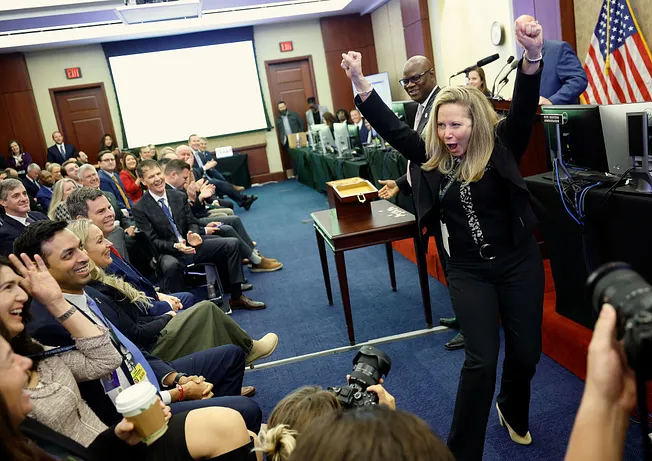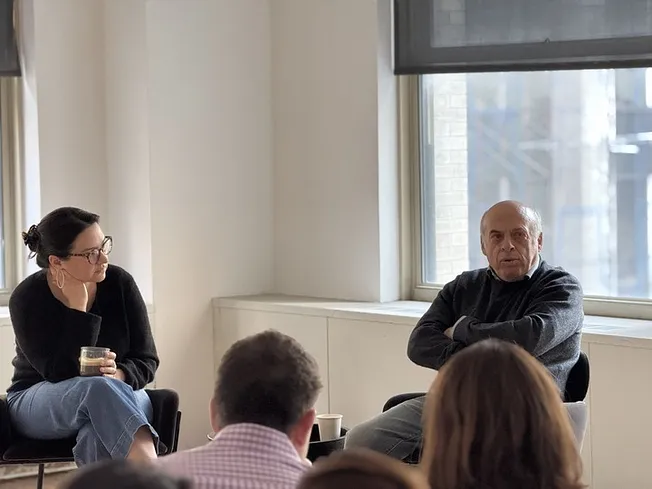On Monday morning, Jay Bhattacharya was feeling optimistic. The Stanford professor of health research policy was in Washington, D.C., to listen to oral arguments in the Supreme Court in Murthy v. Missouri. He is one of the plaintiffs in the case looking at the Biden administration’s efforts to police speech relating to the pandemic and the 2020 election on social media. Last year, Jay’s side won in a lower court. (You can read his op-ed about that victory in The Free Press here.)
Thanks to his dissenting views on everything from lockdowns to masks, Jay was censored by Big Tech during the pandemic. The question for the justices is whether the government violated his First Amendment rights by urging social media platforms to take down certain posts Jay wrote. A lower court ruled that the Biden administration’s requests to remove content were coupled with threats of punishment through heavier regulation—and therefore amounted to unconstitutional coercion.
Jay expected things to go well in the Supreme Court, not least because of the three pro–First Amendment justices appointed by President Trump. But, as he told me when we spoke on Tuesday, “some of the justices showed almost no regard whatsoever for the free speech rights of Americans.” For example, Justice Ketanji Brown Jackson said her “biggest concern” is that the case uses the First Amendment as a means of “hamstringing the government in significant ways.”
As Jay points out, “That’s the very purpose of the First Amendment: to restrict the government from violating basic speech rights.”
Brown Jackson, a liberal justice appointed by President Biden, was always going to be skeptical of Jay’s side of the case. But most Supreme Court reporters agreed that even the court’s swing votes weren’t swinging in a pro–First Amendment direction.
Jay said that after a day of legal argument he “left feeling deflated.” His lawyer, Jenin Younes, wasn’t so gloomy. “It went about as I predicted it would,” she said, sketching out what she saw to be the dynamics on the bench, with three sympathetic justices (Samuel Alito, Neil Gorsuch, and Clarence Thomas), three swing votes (Amy Coney Barrett, Brett Kavanaugh, and Chief Justice John Roberts), and three skeptics (Sonia Sotomayor, Elena Kagan, and Brown Jackson).
The court will hand down its decision by June—and so Jay and his legal team have plenty of time to read the tea leaves.
Meanwhile, Murthy v. Missouri is only one in a series of First Amendment cases being heard by the Supreme Court this session. The others are:
The Netchoice cases, which deal with laws in Texas and Florida that limit the freedom of social media companies to moderate content on their platforms. The cases pit the free speech rights of those companies against the rights of their users.
A case concerning whether a New York official violated the National Rifle Association’s First Amendment rights when, after the 2018 Parkland shooting, she urged banks and insurance companies to stop working with the group.
A case looking at whether public officials can block you on social media. (This week, the court has already decided, unanimously, that they cannot.)
All these cases apply the First Amendment to the social media age, but the first two are most important. With Netchoice, the court will decide whether social media companies should be treated as publishers—or as a modern-day public utility. And with Jay’s case, the court will decide whether the powers of the counter-disinformation complex—through which so much modern censorship occurs—are legitimate, or if those powers need to be checked.
As for Jay, he is still working through the mixed emotions he felt in the courtroom on Monday. “As an immigrant to the United States, I had tingles when I walked into the court,” he said. “I never imagined I would be in the middle of something that, I think, will go down in American history.
“But also, I felt a lot of sadness,” he told me, because his work relies on the First Amendment. “As a scientist and a professor, the heart of my job is to speak. And I have to look over my shoulder and worry whether the government is going to censor my speech. That’s just shocking.”
The Man-Made Miracle of SpaceX
For a media obsessed with Elon Musk, nothing brings more schadenfreude than a SpaceX rocket going up in flames. Except all the gloating over SpaceX’s experiments misses the point. What the press has reported as failure is really its winning formula: learn from your mistakes and iterate quickly until you can repeat success.
Finally, last week, SpaceX notched up a big win when its Starship rocket made it to space.
It was the most exciting moment for American space in years, writes Max Meyer in The Free Press. Yes, the Starship’s Super Heavy booster disintegrated as it reentered the atmosphere, but not before it managed to connect to SpaceX’s satellite internet network and livestream its flight to millions of viewers. Don’t listen to the haters, argues Max. SpaceX is innovating at breakneck speed, reopening the frontier and inspiring the rest of us to do crazy and hard things because they are crazy and hard. And if they figure out a way of colonizing Mars, that’d be cool too.
Here’s Max on the man-made miracle of SpaceX:
Ten Stories We’re Reading
Just 29.8 percent of New Yorkers rate the quality of life in New York City as “excellent” or “good,” compared to 51.2 percent in 2017. It’s up to you, New York. (CBC Resident Feedback Survey)
Joe Biden ruled out supporting Israel’s operation in Rafah in a call with Bibi Netanyahu on Monday. Israel is sending a delegation to Washington to discuss alternatives. And negotiations between Hamas and Israel are back underway in Qatar. (WSJ)
Donald Trump said that “any Jewish person that votes for Democrats hates their religion, they hate everything about Israel, and they should be ashamed of themselves.” (The Hill)
How Trump embraced the January 6 prisoner movement. Please stand for the J6 Prison Choir. (Semafor)
Companies are finding new ways to store energy—in balloons. Is this a climate change game changer? (NYT)
Now’s the time for austerity. Washington, tighten your belt! (Matthew Yglesias)
Europe’s soldiers keep quitting—just when NATO needs them. (Politico)
Protesters in Cuba decry power outages and food shortages. The regime has blamed America. Because of course. (CBS)
Iranians are dancing in the streets—and breaking the rules doing it. (FT)
They praised AI at SXSW—and the audience started booing. (Ted Gioia)
“White Rural Rage” and the Demonization of the Countryside
Remember that brief period of introspection after 2016 when liberal journalists and academics actually showed some curiosity about why, exactly, Donald Trump was so popular—especially among rural, working-class voters? Well, needless to say, we are in a different era now.
The elites have swapped their copies of Hillbilly Elegy for less sympathetic studies—like the book White Rural Rage: The Threat to American Democracy, by Tom Schaller and Paul Waldman. For his piece today, Sohrab Ahmari cracks the spine of this new look at the MAGA faithful and finds it to be exactly as nuanced and fair-minded as its title suggests.
Sohrab finds that the Washington book du jour—which the authors have been plugging in condescending segments on cable news—uses shoddy data to paint a negative picture of the antidemocratic barbarians who lie just beyond the city gates. It’s typical of today’s progressive contempt for rural America, he writes.
Read Sohrab’s full argument here:
If you like what you read, come and listen to Sohrab Ahmari argue that America should shut its borders in our Free Press debate on immigration on April 11 at the Majestic Theatre in Dallas. For tickets and further details, click here.
Chicago Takes Action on the Migrant Crisis. But Are the Voters Any Happier?
In January, Free Press staff writer Olivia Reingold met the Chicagoans furious at their city’s handling of the migrant crisis.
(Read her dispatch: “They’re Black Democrats. And They’re Suing Chicago Over Migrants.”)
Two months on, Chicago’s progressive mayor Brandon Johnson has finally shown signs that he is listening to the voters who say the city is struggling to handle the strain of new arrivals.
This week, Chicago began evictions to enforce a new 60-day limit designed to get migrants out of city-run shelters and into permanent housing. The new policy will see more than 2,000 migrants evicted by the end of April. (Approximately 11,000 migrants are currently housed in city-run shelters.)
Is the eviction policy easing voter anger? Or will the immigration issue continue to turn voters in this deep-blue city red? Olivia made a few calls to find out.
(Trigger warning: if you’re reading this in the White House and don’t want to be in a bad mood for the rest of the day, you may want to skip the next few paragraphs.)
Thomas Simmons is a 70-year-old retired city commissioner who says he “used to be a true Democrat.” He told The Free Press that the new 60-day limit is “full of bull. If you’re going to evict them, why not just send them back?”
Simmons, who is black, says the migrant crisis has forced him to reconsider his political allegiances: “It made me more open to Trump. When he wins, he’s going to send them back. . . . Honestly, I’m going for Trump.”
Roland Dates, a black, 62-year-old lifelong Democrat from Chicago’s West Side, says the migrant crisis keeps getting worse. Speaking to The Free Press the day before the Illinois primary, he said, “I’m going to go straight Republican. . . I’ve got to go with the lesser of two evils.”
Dates is skeptical that the 60-day eviction policy will really change how the city handles migrants. “That’s a game,” he says. “They say that, but they’ll just get an extension and another extension.”
Of his voting intentions come November, he says: “I guess Trump’s the man.”
Letters to the Editor: Lockdown Edition
On Saturday, we ran the latest installment of our Prophets series, which pays tribute to thinkers from the past who predicted our current moment. For his entry, Joe Nocera wrote about D.A. Henderson, the epidemiologist credited with eradicating smallpox who warned against shutting down the world to combat a pandemic.
Joe’s article prompted a response from someone who actually knew Henderson, who died in 2016: Donald G. McNeil Jr., the former New York Times science correspondent and author of a new book on pandemics, The Wisdom of Plagues. Here’s his letter:
Joe Nocera suggests that D.A. Henderson, were he alive today, would agree with the premises of Joe’s new book, The Big Fail, particularly the idea that lockdowns were the wrong response to the Covid pandemic.
Unlike Joe (I suspect), I actually knew D.A. Henderson. I interviewed him frequently and I wrote his New York Times obituary—from which Joe quotes. When presented with new facts, D.A. would change his mind. I gave examples of that in the obit. While Joe is correct in saying that Henderson warned that closing down society to stop a pandemic would have unpleasant consequences, that does not mean he would have backed the absurd idea advanced in the Great Barrington Declaration that we should have just let the virus rip through the population (while somehow—they never explained how—magically “protecting the vulnerable”). That was a ridiculous, dangerous idea, and the Great Barrington epidemiologists—and their acolytes, like Scott Atlas, a member of Trump’s White House Coronavirus Task Force—kept insisting that the end of the pandemic was just around the corner, thanks to their theory that it would stop when 30 percent of the population had been infected. They were wrong. As early as the late summer of 2020, Atlas was insisting that the epidemic was fading away. At the time, about 200,000 Americans were dead; another 900,000 more would die after he made that statement.
Joe cites Sweden as a model we should have emulated. It’s an article of faith among lockdown skeptics that Sweden did great during the pandemic. It did not. It became famous in the spring of 2020 for taking a laissez-faire approach. Before the year ended, the country—including the king and the epidemiologist who came up with the laissez-faire policy—admitted that it had failed because so many Swedes had died (mostly in nursing homes). Lockdowns and school closures, much like those in the rest of Europe, were imposed. By the time the pandemic was over, Sweden had a far higher Covid death rate than any of its neighbors (about 2,700 deaths per million vs. 1,200 for next-door Norway). It had more deaths per capita than Germany and was on a par with Spain and France. In other words, it did just about average in Western Europe.
And the U.S. did terribly, with a higher Covid death rate (3,600/million) than any Western European country. In my book The Wisdom of Plagues I, like Joe, argue that we failed terribly in the face of Covid—but because we reacted too slowly, too incompetently, with too much political fragmentation. And that ultimately, the most important reason for our high death rate was vaccine rejection.
I’ve been denounced as a totalitarian for arguing in favor of a rapid, aggressive, Pentagon-like response to epidemics, for closing borders, restricting travel, ending home quarantine, ending religious exemptions, and imposing rigorous vaccine mandates (and, yes, brief but rigidly enforced shutdowns and mask mandates if testing data suggest that they will keep local hospitals from being overwhelmed—not to please teachers unions). I estimate that our failed response meant we lost almost 550,000 more lives than we should have to Covid. And I think that if we don’t get better at this, we’ll lose more Americans next time.
And I’m pretty sure D.A., were he still alive, would agree with me rather than with Scott Atlas.
—Donald G. McNeil Jr
And here’s Joe’s response:
Donald McNeil spent most of his career as an infectious disease reporter for The New York Times, so it’s not a surprise that he advocates for the Covid mitigation measures championed by his public health sources. But that also causes him to share the same blind spots—overlooking important factors that Henderson pointed out in his 2006 paper.
The first is that a “rapid, aggressive, Pentagon-like response” doesn’t take into account a hugely important factor: human behavior. You simply can’t lock people up in their homes, shut down their businesses, eliminate every venue for human contact and enjoyment, and expect people to put up with it indefinitely. China took exactly that approach, and its citizens ultimately revolted. When the government finally relented and allowed cities like Shanghai to open up again, a lot of people died.
Second, Henderson understood, as I quoted him in my story: “You have to be practical, and you have to be humble, about what public health can actually do, especially over sustained periods.” The person who recalled that quote for me was Dr. Tara O’Toole, Henderson’s longtime number two. I venture that she knew him even better than McNeil. And much of what McNeil calls for, such as travel restrictions, simply don’t work. We know now that most of the masks people used during the pandemic didn’t stop the virus either. Lockdowns? The evidence is overwhelming that lockdowns did not ultimately save lives.
Third, McNeil fails to make important distinctions—distinctions that are key to understanding the rationale behind the Great Barrington Declaration. As Martin Kulldorff, one of the authors of that document, told me, “There is an enormous age difference in the risk of mortality—a thousandfold difference between the old and the young.” The elderly were highly vulnerable to the virus, but as you went down the age scale, people were less likely to die from it. And the number of children who died of Covid was miniscule. McNeil doesn’t mention the harm done to children by lengthy school closings, but it was far worse than any harm inflicted on them by the pandemic. On the flip side, of the 1.1 million Americans who died of Covid, some 200,000 were nursing home residents. McNeil scoffs at the idea that society could protect the elderly while letting the rest of society function, but of course we could. We just chose not to.
McNeil’s view that D.A. Henderson would have turned his back on his lifelong beliefs, based on real-world experience, seems pretty unlikely. So much of life requires balancing risks versus rewards. Pandemics are no different. As bad as the virus was, public-health experts made a grievous mistake overselling the risks to the exclusion of all else. That is why they have so little credibility today. That’s what Henderson understood, and McNeil doesn’t.
—Joe Nocera
Got an interesting perspective on a Free Press story? Write to us! letters@thefp.com
Oliver Wiseman is a writer and editor for The Free Press. Follow him on X @ollywiseman.
To support independent journalism, become a Free Press subscriber today:

















our Comments
Use common sense here: disagree, debate, but don't be a .